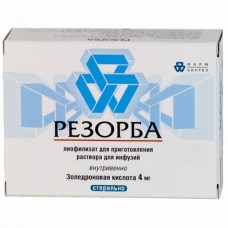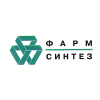Expiration date: 06/2026
The composition and form of issue:
Lyophilisate for preparation of solution for infusion. 1 vial contains:
of zoledronic acid monohydrate of 4.26 mg
(corresponds to the anhydrous of zoledronic acid — 4.0 mg)
excipients: D-mannitol sodium citrate
the composition of the solvent: water for injections
in dark glass bottles or in packs of contour plastic 1 bottle (complete with the solvent in vials) in the paper cartons 1 set.
Description pharmaceutical form:
Lyophilisate: white or almost white.
Solvent: clear, colorless liquid with no odor.
Pharmacokinetics:
Pharmacokinetic parameters are not dose-dependent. After the start of infusion, the concentration in serum increases rapidly, reaching Cmax at end of infusion, followed by a rapid reduction in the concentration: 10% after 4 h and less than 1% of Cmax in the 24 h with a further long period of low concentrations not exceeding 0.1% of the Cmax, until the second infusion on day 28.
The plasma protein binding is 56%. Not metabolizmu.
Excreted by the kidneys in unchanged form in 3 stages: 1 and 2 stages — rapid excretion of the drug from the systemic blood circulation, with a T1/2 — 0,24 1,87 h and h, respectively, and stage 3 — long, with a T1/2 — 146 hours-No observed drug accumulation after repeated administration every 28 days. During the first 24 h in the urine detected by 23-55%. The remainder of the drug binds to bone tissue, after which there is slow its release back into the systemic circulation and renal excretion with the feces is excreted less than 3%. The total plasma clearance is 2.54–7, 54 l/h. It does not depend on the dose, sex, age, race and body mass of the patient. Increasing the length of infusion from 5 to 15 min leads to reduction of the concentration of zoledronic acid at 30% at the end of the infusion, but does not affect AUC.
Renal clearance is positively correlated with Cl creatinine is 42-108% of Cl creatinine average 55-113%. In patients with severe (Cl — creatinine <20 ml/min) and moderate (Cl creatinine is <50 ml/min) renal impairment the clearance of zoledronic acid is 37 and 72% respectively from the values of clearance of the drug in patients with Cl creatinine 84 ml/min.
Description pharmacological action:
Resorb the drug belongs to a new class of highly effective bisphosphonates with selective effect on bone tissue. Suppresses osteoclast activity, does not render undesirable influence on formation, mineralization and mechanical properties of bone tissue. Selective action of bisphosphonates on bone tissue is based on high affinity for mineralized bone, but the exact molecular mechanism for the inhibition of the activity of the osteoclasts is still unclear. Also has direct anti-tumor properties, provides efficacy in bone metastases.
Established In vitro, zoledronic acid, inhibiting the proliferation and inducing apoptosis of cells, has direct antitumor effects on myeloma cells and breast cancer, reduces the risk of metastasis. Inhibition of osteoclastic bone resorption, altering the microenvironment of the bone marrow, causes reduction of tumor cell growth observed anti-angiogenic and analgesic activity.
Zoledronic acid also inhibits the proliferation of endothelial cells in humans. If hypercalcemia is caused by a tumor, reduces the concentration of calcium in the blood serum.
Indications:
- osteolytic, osteoblastic and mixed bone metastases of solid tumors
- osteolytic lesions in multiple myeloma
- hypercalcemia caused by malignant tumor.
Contraindications:
- hypersensitivity of zoledronic acid, other bisphosphonates or any other components included in the composition of the drug
- expressed kidney failure (Cl creatinine is <30 ml/min).
- pregnancy and breast-feeding
- childhood and adolescence (safety and efficacy have not been established).
With caution:
- violation of kidney function
- severe hepatic insufficiency (no data use)
- patients with asthma who are sensitive to acetylsalicylic acid.
Application of pregnancy and breast-feeding:
Contraindicated in pregnancy. At the time of treatment should stop breastfeeding.
Side effects:
Adverse reactions are listed below according to the organs and systems, indicating the frequency of their occurrence. Criteria frequency: very common &ge1/10 often &ge1/100 — <1/10 sometimes &ge1/1,000 to <1/100 rare &ge1/10,000 to <1/1,0 very rare <1/10,0 (including private messages).
On the part of the blood: often — anemia, sometimes — thrombocytopenia, leukopenia rare — pancytopenia.
From the nervous system: often — headache sometimes — dizziness, paresthesia, disorders of taste sensations, hypoesthesia, hyperesthesia, tremor, anxiety, sleep disorders, rarely — confusion.
From the side of organs of vision: often — conjunctivitis sometimes "blurring" of vision very rarely uveitis, episcleritis.
From the digestive tract: often — nausea, vomiting, anorexia and sometimes diarrhea, constipation, abdominal pain, dyspepsia, stomatitis, dry mouth.
The respiratory system: sometimes — shortness of breath, cough.
The skin and skin appendages: sometimes — itching, rash (including erythematous and macular), excessive sweating.
From the side of musculoskeletal system: often — pain in bones, myalgia, arthralgia, generalised pain and sometimes muscle spasms.
Of the cardiovascular system: sometimes- pronounced increase or decrease in blood pressure, rarely — bradycardia.
From the urinary system: often — violation of kidney function and sometimes acute renal failure, hematuria, proteinuria.
The immune system: sometimes — hypersensitivity reactions rarely — angioedema.
Violations of laboratory parameters: very often — hypophosphatemia often — increased serum concentrations of creatinine and urea, sometimes hypocalcemia — hypomagnesemia, hypokalemia rare — hyperkalemia, hypernatremia.
Local reactions: pain, irritation, swelling, education infiltrates at the injection of the drug.
Other: often — fever, flu-like symptoms (including malaise, chills, painful condition, heat), sometimes — asthenia, peripheral oedema, pain in chest, weight gain.
When treating patients with bisphosphonates, including zoledronic acid, sometimes there were cases of developing osteonecrosis of the jaw (usually after tooth extraction or other dental procedures).
In very rare cases, decrease in blood pressure during therapy of zoledronic acid led to syncope or circulatory collapse.
Drug interactions:
As solvents cannot be used solutions containing calcium, including ringer solution.
While the use of anticancer drugs, diuretics, antibiotics, analgesics clinically significant interactions are not marked.
Bisphosphonates and aminoglycosides have a unidirectional influence on the calcium concentration in the serum, so their concurrent use increases the risk of hypocalcemia and hypomagnesemia.
Caution is needed in concomitant use of zoledronic acid drugs, with potentially nephrotoxic effects.
In patients with multiple myeloma may increase the risk of developing impaired renal function at/in the introduction of bisphosphonates in combination with thalidomide.
The drug should not be mixed with other drugs.
Method of application and dose:
In/in drip for at least 15 min.
Of bone metastases and osteolytic lesions in multiple myeloma the recommended dose is 4 mg every 3-4 weeks. It is recommended to additionally assign inside the preparations containing calcium, in the dose of 500 mg/day and vitamin D at a dose of 400 IU/day.
If hypercalcemia (calcium concentration with correction for the level of albumin 12 mg/DL or 3 mmol/l) caused by malignant tumors, the recommended dose is 4 mg once. The infusion is carried out under conditions adequate hydration of the patient.
Patients with impaired renal function
Hypercalcemia caused by malignant tumors. The decision about the treatment of zoledronic acid in patients with severe renal dysfunction should only be taken after careful evaluation of risk/benefit. When the concentration of creatinine in serum <400 µmol/l (<4.5 mg/DL), correction dosing regimen is not required.
Bone metastases common malignant tumors and multiple myeloma. The dose of zoledronic acid depends on the initial level of Cl creatinine calculated by the formula of Cockcroft-Gault. In severe renal impairment (Cl creatinine <30 ml/min) use zoledronic acid is not recommended.
The recommended dose for mild or moderate impaired renal function (values Cl creatinine 30-60 ml/min) given below.
| The initial value of Cl creatinine, ml/min | The recommended dose of zoledronic acid, mg |
| >60 | 4,0 |
| 50–60 | 3,5 |
| 40–49 | 3,3 |
| 30–39 | 3,0 |
Determination of the concentration of serum creatinine should be checked before each dose of the drug. When violations of the kidney another infusion of zoledronic acid should be postponed. Violations of kidney function are defined by the following parameters:
For patients with normal baseline values of creatinine (<1.4 mg/DL) — increase of creatinine content in serum of 0.5 mg/DL.
For patients with deviations of baseline creatinine (>1.4 mg/DL) — increase in the content of creatinine in serum by 1 mg/DL.
Therapy of zoledronic acid resumes only after the creatinine level reaches values above the initial value not more than 10%, the same dose that was used prior to the interruption of treatment.
Preparation of injection solution
The solution is prepared under aseptic conditions 4 mg dissolved in 5 ml of water for injection, gently shaken until fully dissolved. The resulting solution with the required dose is diluted in 100 ml 0.9% sodium chloride solution or 5% dextrose solution. Do not use solutions containing calcium. The prepared solution is desirable to use ex tempore. Unused solution can be stored in the refrigerator at 2-8 °C for no longer than 24 h. the Solution was stored in refrigerator prior to injection should be warmed to room temperature.
Overdose:
Symptoms: accidental overdose, the patient should be under constant surveillance. May cause hypocalcemia, accompanied by clinical manifestations.
Treatment: an infusion of calcium gluconate.
Special instructions:
Before infusion, ensure adequate hydration of the patient. If necessary, that the introduction of the saline solution before, concurrently or after infusion of zoledronic acid. You should avoid over-hydration of the patient because of the risk of occurrence of complications in the cardiovascular system.
After the introduction of the drug requires constant monitoring of the concentration of calcium, magnesium, phosphorus and creatinine in serum.
The therapy of zoledronic acid should be monitored closely for kidney function. The risk factors of impaired renal function include dehydration, pre-renal failure, multiple doses of zoledronic acid or other bisphosphonates as well as use of nephrotoxic drugs, and too rapid administration of the drug.
It should be borne in mind that when you assign other bisphosphonates to patients with asthma who are sensitive to acetylsalicylic acid, there have been cases of bronchospasm, however, the use of zoledronic acid, such cases are not yet registered.
On the background of treatment with bisphosphonates, including zoledronic acid, cancer patients described the development of osteonecrosis of the jaw, therefore before treatment bisphosphonates it is necessary to provide a dental examination and in case of presence of risk factors (anemia, coagulopathy, infection, poor hygiene or disease of the oral cavity, and related chemotherapy or radiation therapy, treatment with corticosteroids) to conduct appropriate preventive procedures. The treatment of zoledronic acid to patients with risk factors, if possible, avoid dental surgeries.
Expiration date:
The solvent is 4 years.


